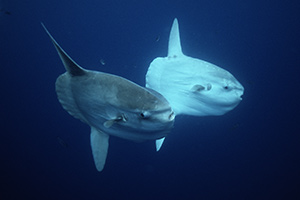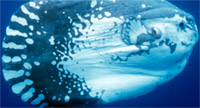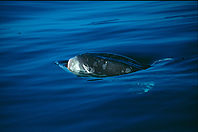SIZE, GROWTH and LONGEVITY
The average size of an adult Mola mola is 1.8 m (6ft) from snout tip to the end of the clavus (pseudo-tail) and 2.4 m (7 ft 10 in) between the tips of the dorsal and anal fins. The average weight is up to 1 metric ton (2200 lbs).
The heaviest mola on record came from Japan, Mola alexandrini, was 2.7 meters (8.9 feet) long and weighed 2.3 metric tons (5,071 pounds). Before this discovery the largest Mola ever recorded weighed 2235 kg (4,927 lbs) and measured 3.1 m (10 ft) from snout tip to “tail” fin, 4.26 m (14 ft) from dorsal fin to anal fin tip. That animal was struck by a boat off Sydney, New South Wales, Australia in September, 1908 (Carwardine, 1995). It is likely there have been larger molas but scales were not readily available to take formal measurements.
No data exist on how fast mola grow in the wild but one Mola mola individual in captivity at the Monterey Bay Aquarium gained 364 kg (800 lbs) in 14 months. Fattened up on a diet of squid, fish and prawns, this fish had to be airlifted out by helicopter and released into the bay after outgrowing its million gallon tank. (Powell. D. 2003 A Fascination for Fish, UC Press/Monterey Bay Aquarium Series in Marine Conservation.)
The longevity of molas in the wild is also a mystery although Kamogawa SeaWorld in Japan housed the same individual for more than 10 years in captivity. (Nakasubo et al. 2007, Growth of captive ocean sunfish, Mola mola Suisan Zoshoku 55: 403-407.) A growth curve derived from repeated measurements of captive individuals estimated animals with a total length of 3m would be approximately 20 years old (Nakatsubo, T. 2008 A study on the reproductive biology of ocean sunfish Mola mola. Dissertation. International Marine Biological Institute. Kamagawa Sea World, Japan). Liu et al 2009 examined vertebral growth rings in Masturus from Taiwan and estimated lifespan of individuals greater than 2 to 23 years for females and 1-16 years for males. Accurately estimating and measuring the age of wild mola remains a work in progress.


COLORATION
Mola come in a variety of gray and white patterns with some sporting your basic gray motif while others go for the more polka-dotted appaloosa style. Many also have a slight iridescent sheen. Certain geographic areas seem to have discrete color patterns—for example the mola in Bali appear darker than those off Southern California. Molas may have specific traceable patterns individual identification research is taking place in Bali and Galapagos.
Mola are capable of color changes particularly when stressed or under attack from a sea lion or other predator and can turn from light to dark within a matter of moments.

DIET
Recent examination of the diet of ocean sunfishes has challenged the traditional characterization of sunfishes as peripheral players in marine food webs and obligate gelativores (e.g. Pope et al. 2010). Rather, a broader and more comprehensive examination of sunfish trophic position and diet has revealed that they exhibit ontogenetic differences in prey types (i.e. what they eat changes as they develop), and they consume both gelatinous and non-gelatinous taxa.
Smaller sunfish (less than a meter in total length) consume a mixed diet of benthic (bottom) and pelagic (open ocean) prey. Often these juvenile sunfishes may school together and consume nearshore prey taxa, including fishes, squids, crustaceans and jellies. As sunfish grow larger, they may become more solitary and shift towards consuming pelagic gelatinous zooplankton (Harrod et al. 2013, Nakamura and Sato 2014, Sousa et al. 2016, Phillips et al. 2020). This shift in diet from a high-energy, mixed diet towards consuming primarily lower-energy gelatinous taxa with larger size may seem puzzling at first glance. However, these larger predators may shift towards a lower-energy diet because they may become more energy-efficient and we may also have historically underestimated the nutritional value of gelatinous zooplankton (e.g. Drazen and Sutton 2016, Briz et al. 2017, Phillips et al. 2017, Hays et al. 2018, Phillips et al. 2020).
Sunfish Diet FAQ
How is sunfish diet studied?
Traditionally, many fish diets can be examined using stomach content analysis of recovered specimens. However, since sunfishes consume many gelatinous prey, which are often especially susceptible to digestive processes, we use several complementary methods to assess diet, including: stomach content analysis, stable isotopes, genetic identification of prey items, and sunfish-borne cameras (e.g., Harrod et al. 2013, Nakamura and Sato 2014, Sousa et al. 2016. Phillips et al. 2020).
Sunfish Diet Cited Literature:
Briz, L.D., F. Sanchez and N. Mari. 2017. Gelatinous zooplankton (ctenophores, salps and medusae): an important food resource of fishes in the temperate SW Atlantic Ocean. Marine Biology Research 13(6): 630–644.
Drazen, J.C. and T.T. Sutton. 2016. Dining in the Deep: The Feeding Ecology of Deep-Sea Fishes. Annual Review of Marine Science 9: 337–366.
Harrod, C., J. Syvaranta, L. Kubicek, V. Cappenera and J. Houghton. 2013. Reply to Logan and Dodge: Stable isotopes challenge the perception of ocean sunfish Mola mola as obligate jellyfish predators. Journal of Fish Biology 82(1): 10–6. Available at: http://www.ncbi.nlm.nih.gov/pubmed/23331134.
Hays, G.C., T.K. Doyle and J.D.R. Houghton. 2018. A Paradigm Shift in the Trophic Importance of Jellyfish? Trends in Ecology and Evolution 33(11): 874–884.
Nakamura, I. and K. Sato. 2014. Ontogenetic shift in foraging habit of ocean sunfish Mola mola from dietary and behavioral studies. Marine Biology 161(6): 1263–1273. Available at: http://link.springer.com/article/10.1007/ s00227-014-2416-8/fulltext.html.
Phillips, N., L. Eagling, C. Harrod, V. Cappenera, J. Houghton and N. Reid. 2017. Quacks snack on smacks: mallard ducks (Anas platyrhynchos) observed feeding on hydrozoans (Velella velella). Plankton and Benthos Research 12(2): 143–144. Available at: https://www.jstage.jst.go.jp/article/pbr/12/2/12 P120207/ article.
Phillips, N.D., E.A.E. Smith, S.D. Newsome, J.D.R. Houghton, C.D. Carson, J.C. Mangel et al. 2020. Bulk tissue and amino acid stable isotope analyses reveal global ontogenetic patterns in ocean sunfish trophic ecology and habitat use. Marine Ecology Progress Series 633: 127–140.
Phillips, N.D., E.C. Pope, C. Harrod, J.D.R. Houghton. 2020 The Diet and Trophic Role of the Ocean Sunfishes pp. X-X In: T. M. Thys, G.C. Hays and J.D.R. Houghton [eds.]. The Ocean Sunfishes: Evolution, Biology and Conservation, CRC Press. Boca Raton, FL, USA.
Pope, E.C., G. Hays, T. Thys, T. Doyle, D. Sims, N. Queiroz et al. 2010. The biology and ecology of the ocean sunfish Mola mola: A review of current knowledge and future research perspectives. Reviews in Fish Biology and Fisheries 20(4): 471–487.
Sousa, L.L., R. Xavier, V. Costa, N. Humphries, C. Trueman, R. Rosa et al. 2016. DNA barcoding identifies a cosmopolitan diet in the ocean sunfish. Scientific reports. 6(June), p. 28762. Available at: http://www.pubmedcentral.nih.gov/articlerender.fcgi?artid=4931451andtool=pmcentrezandrendertype=abstract.
